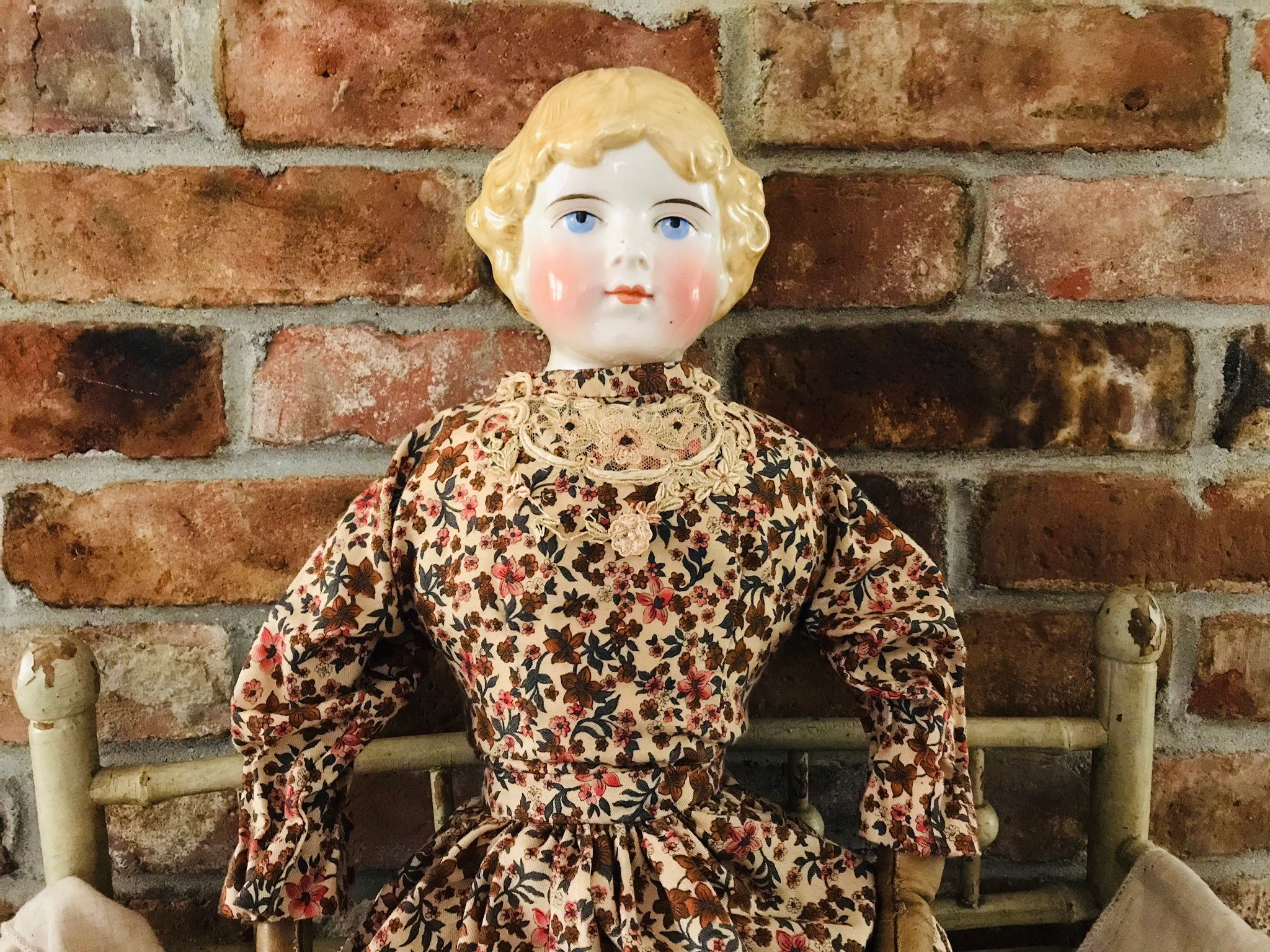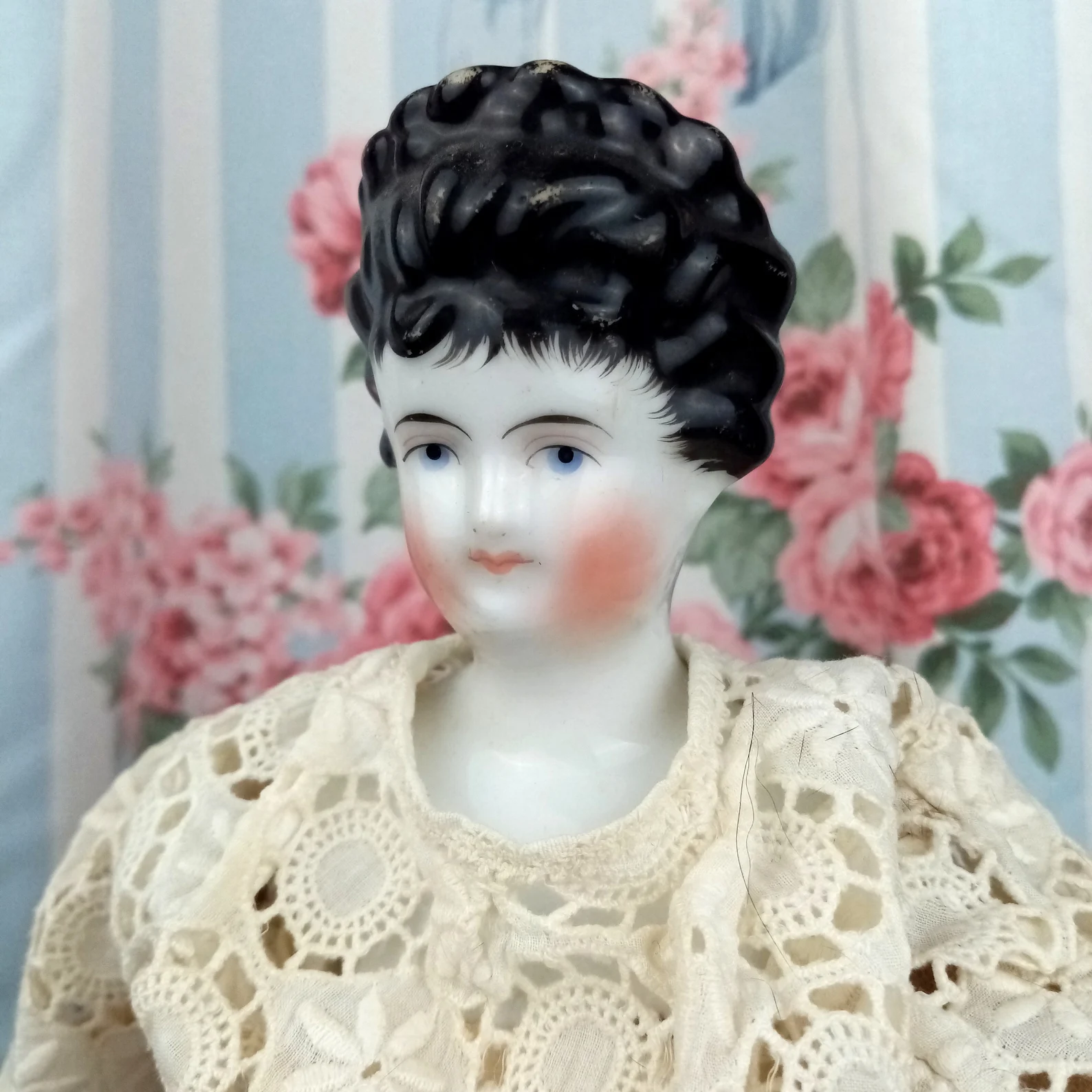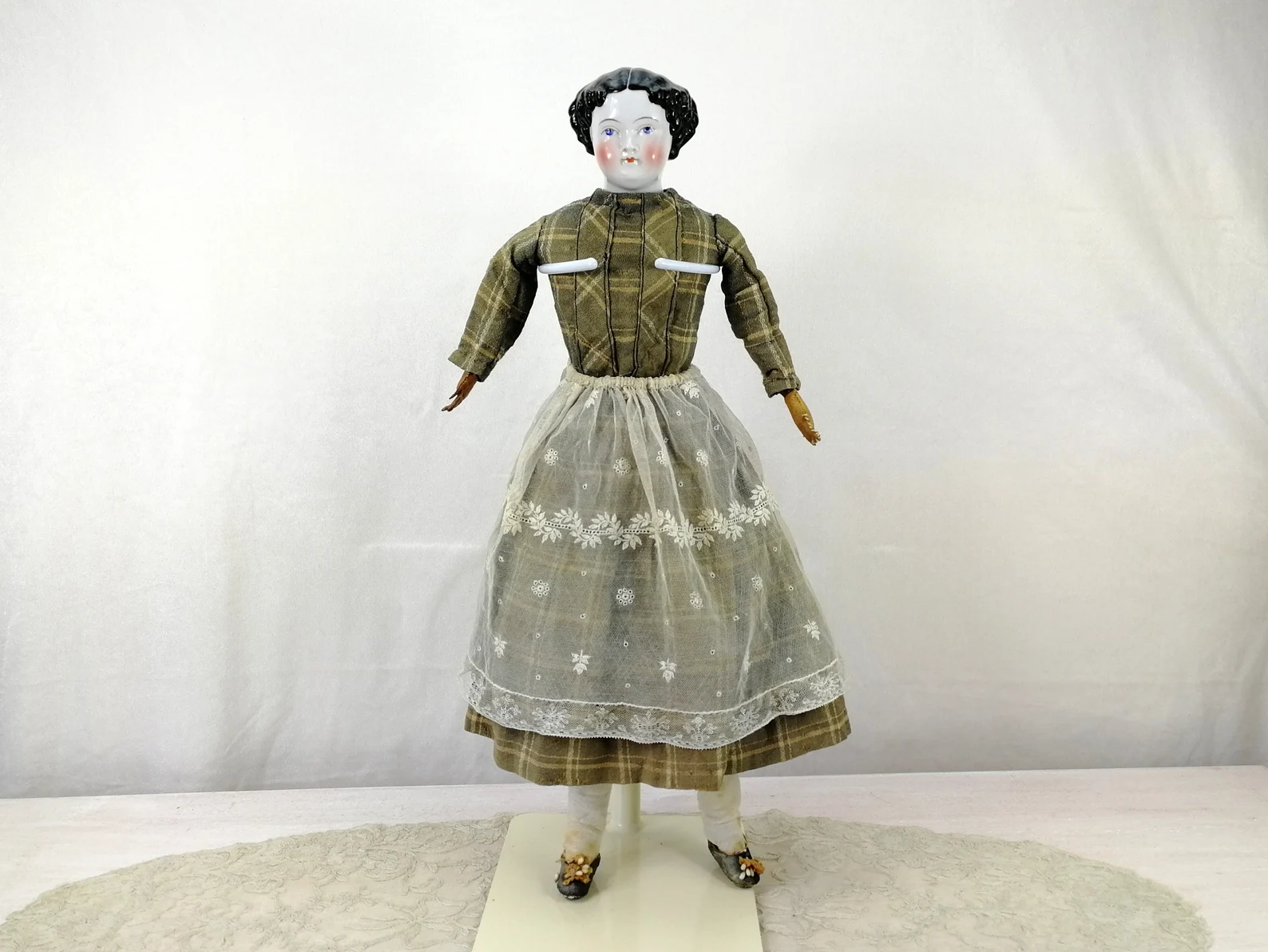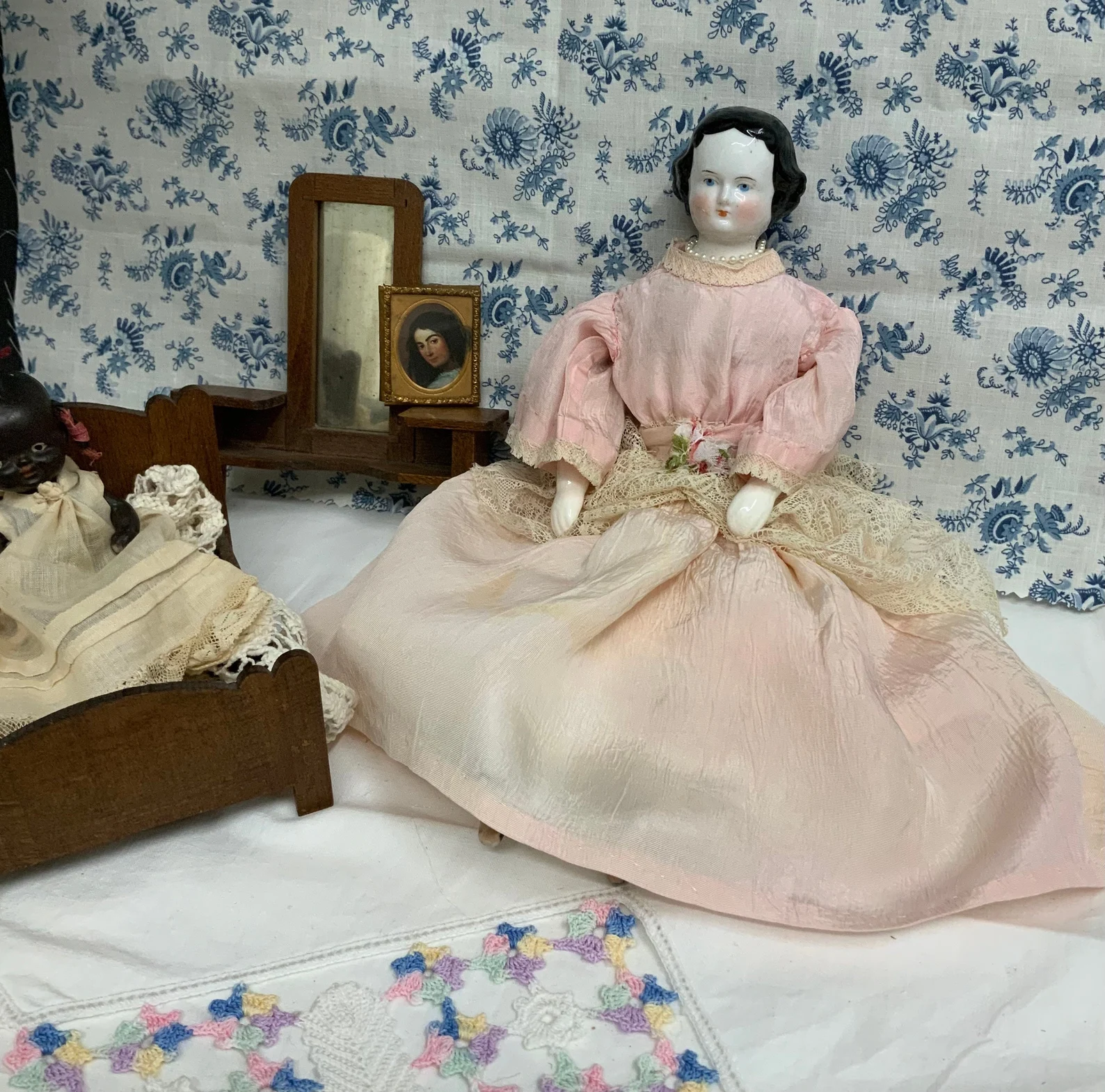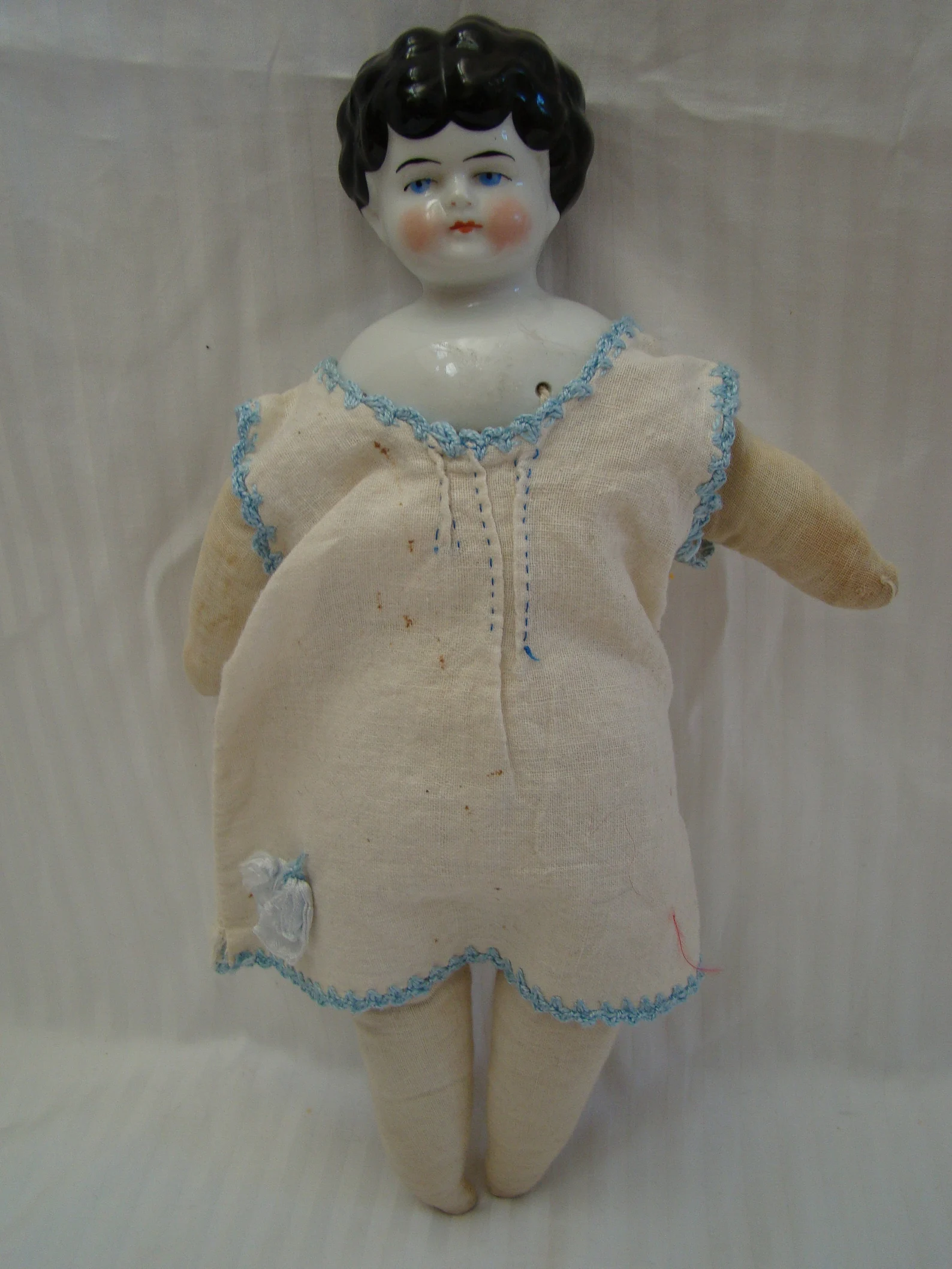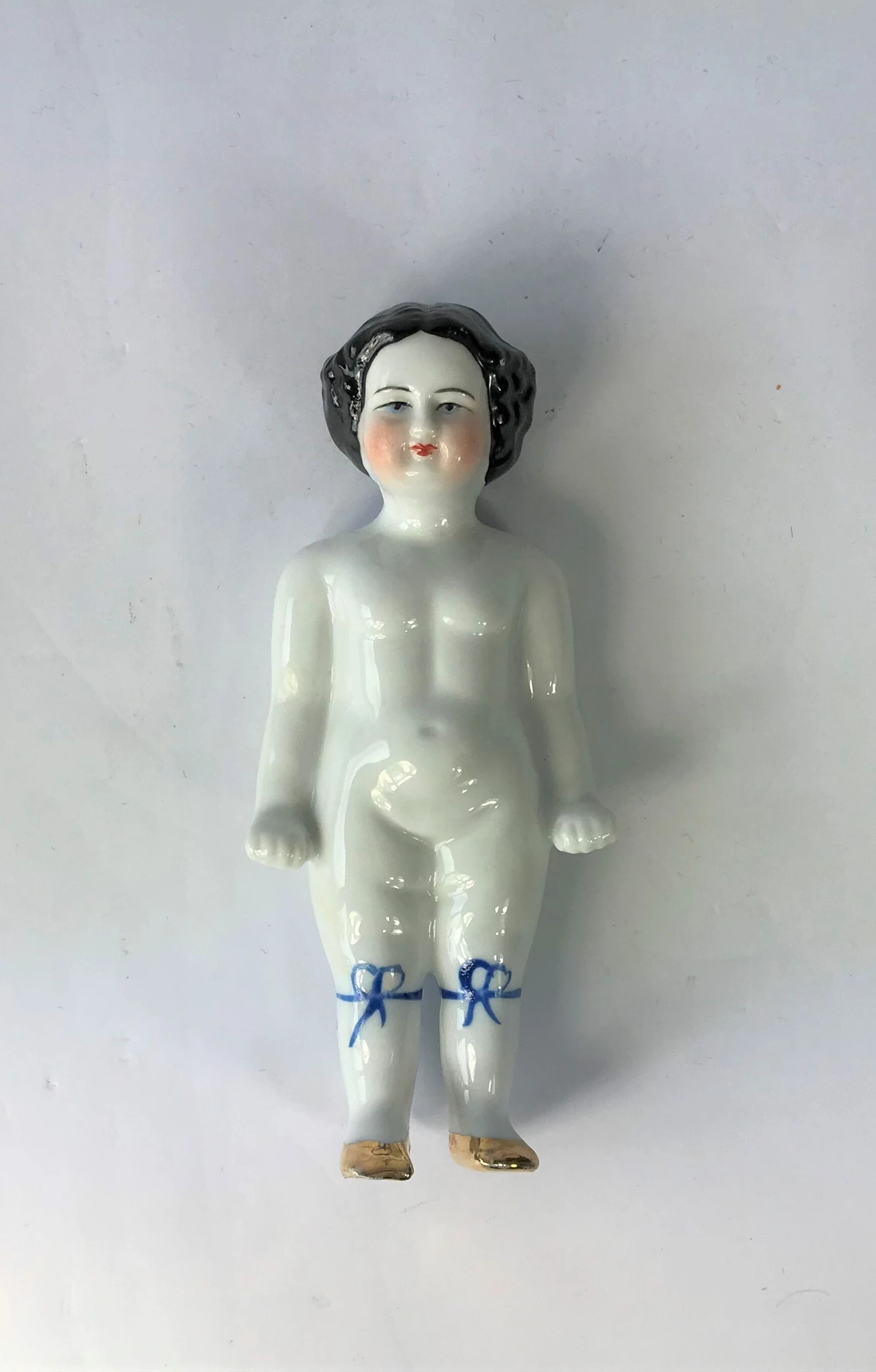Most people associate dolls with children’s play; however, dolls have a far deeper cultural and historical significance, with many being highly valued by doll collectors. Archaeologists even found dolls that date back to over 4,000 years ago, proving that dolls were made since the dawn of human civilization. There are many fascinating dolls out there, but a type of doll that caught my attention recently is a china head doll.
The name of this toy might be misleading because it didn’t originate from China. It was actually produced in Germany between 1840 and 1940, but also in some other countries, like Poland, Czechoslovakia, France, Denmark, and Sweden. These dolls got their name because their heads were made of porcelain, sometimes referred to as china.
China head dolls had porcelain heads, necks, and shoulder plates. The rest of their body and limbs were usually made of cloth and leather, but some of these dolls were entirely made of porcelain.
China doll head was glazed, with a molded hairstyle usually representing the current hairstyle trends. Face features were painted on the doll’s face, and these dolls usually had blue eyes and black hair, although blonde ones were also popular.
Table of Contents
The History of China Head Doll
China head dolls first started to be produced in the 1800s, when Germany began to produce fine china in its own factories, relying less on importing porcelain from China to Europe.
Companies such as KPM Meissen, Kestner, and Conta & Boehme were among the most famous makers of German china dolls. Some other companies that made these dolls were Kling, Kister, and Alt, Hertwig and Beck & Gottschalck.
The first china head dolls were made to resemble young grown women, especially if they were well-known. For example, when Queen Victoria ascended Great Britain’s throne in 1837, many china head dolls were made to resemble her.
Starting in the 1850s, they were made to look like small children, which proved to be a massive success among the buyers. Around that time, every major manufacturer started selling these dolls in parts or kits, enabling the buyers to make their own dolls and dress them as they wanted.
Their leather or cloth bodies were filled with horsehair, sand, straws, or other materials. Some doll bodies were made of wood briskets or completely out of porcelain. China head dolls came in various sizes, ranging from 1 to more than 30 inches.
Fashion dolls also appeared in the mid-1800s, wearing the latest fashion clothing from that specific era. For example, in the 1860s, these dolls wore a bolero-style straw bonnet and red leather shoes. Some of these dolls even had pierced ears, or they wore patterned stockings and trendy boots.
In the Victorian era, it wasn’t unusual for the china head doll to wear an elaborate wig made of real hair, with beautiful curls and even a ribbon. Although most dolls were made to resemble young women and girls, boy dolls and baby dolls could also be found.
Because of the “McKinley Tariff Act” of 1890, which required goods to be labeled with the nation of origin, the china head dolls were marked with “Germany” in the late 19th and early 20th centuries. Furthermore, since 1921, every china head doll has been required to be labeled “made in Germany” due to a law that added “made in” to the mark section.
In the 1880s, France and Germany started manufacturing a new type of doll called the bisque doll. Bisque dolls soon became widely popular and spread to the United States and China. In the early 20th century, china head dolls slowly started to lose popularity, and their sales declined significantly by the middle of the 20th century.
The production continued in the United States and Japan, aiming to recreate the original dolls. The quality of the new dolls, however, was inferior to that of the originals. In the 1970s and 1980s, antique china head dolls captured the attention of doll collectors and became a valuable item to own.
The Difference Between China Head Doll and Porcelain
There are many types of ceramic porcelain dolls, with the most popular being the china head dolls and bisque dolls. Both types first appeared in the 1800s, with china head dolls made in Germany and bisque dolls made in Germany and France.
Both dolls have a porcelain head with a cloth body, but unlike china head dolls, bisque dolls are unglazed. Instead, the head of a bisque doll has a matte finish, giving it a texture more similar to the real human’s skin.
A little More About Bisque Dolls
Bisque dolls were at first made in France, but their production quickly spread to Germany in the 1880s. Soon, bisque dolls became more popular than china head dolls. They usually had elaborate wigs made of mohair or real human hair.
China head dolls had all of their face features painted on, while bisque dolls had glass eyes that looked more natural and appealing. Just like china head dolls, bisque dolls represented grown women at first but later changed their appearance to childlike.
Bisque dolls were more decorative than china head dolls. They were often dressed in lace dresses and they even wore jewels and flowers. Bisque dolls eventually exceeded china head dolls in popularity, and every affluent family in Germany owned at least one bisque doll.
China Head, Bisque, or Porcelain?
Although this is incorrect, the terms china head doll, bisque doll, and porcelain doll are sometimes used interchangeably. While the terms bisque doll and porcelain doll are synonymous because they refer to the same thing, the term china head doll is reserved for dolls with glazed porcelain heads.
How do I identify a china doll?
China head dolls are extremely popular among antique doll collectors even today, almost 200 years after they were manufactured for the first time. In the age of e-commerce stores, finding antique china head dolls is easier than ever, but you still need to keep some things in mind when looking.
The hair, head, neck, and shoulder plates on the china head doll are made of white glazed porcelain, which gives them a particular glossy appearance. The facial features are painted on, and the body is usually made of cloth or leather.
The doll’s arms and legs were sometimes made of porcelain as well, and these dolls very rarely had a whole porcelain body. China head dolls were dressed in a costume characteristic of the time period when they were manufactured.
How To Identify The Manufacturer?
Most china head dolls are unmarked or marked with their size number. Sometimes you will be able to find the name of the manufacturer and model number imprinted on the doll. If you don’t see any marking on the doll, you can check its details for the identification of the manufacturing company.
For example, if you see a thin unpainted space between the doll’s lower and upper lip, that china head doll was made by the Kestner company. On the other hand, Alt Beck & Gottschalk’s dolls had a black line between the upper and lower lip.
However, identifying a doll as the china head doll and guessing its manufacturer isn’t enough. You must also ensure that the doll is an authentic antique rather than a cheap replica.
Is Your China Head Doll Real or Fake?
The most common telltale sign that a certain doll is just a cheap reproduction is the low quality of its painted facial features. Real antique china head dolls have carefully painted eyes, lips, and eyebrows. On the other hand, the paint on the replicas often looks smudgy and like it was done in a hurry.
Antique china dolls often have tiny black specks inside the glaze. These specks are actually small dust particles that ended on the glaze during the firing process.
Replicas often have fine crazing all over the glazed surface, which doesn’t happen with real antique dolls. In addition, copies are frequently manufactured of weaker and softer clay materials rather than true china, which lowers their quality.
Finally, if the doll has markings indicating that it was created in the United States, Japan, or any other country (that’s not Germany), you aren’t looking at an antique china head doll, because these countries only began producing china head dolls after WWII.
What is a china head doll worth?
There are several factors that determine the value of a particular china head doll. Obviously, the condition of the head and body is the most important factor. The value of the doll will plummet if the head has chips, cracks, or missing details.
If you notice that some elements of the doll’s body are missing, or that the doll’s body has been subjected to repairs that changed its structure and added new materials, the doll’s value will be reduced.
China head dolls are categorized into 6 stages of condition: mint, near mint, very fine, fine, good, and poor. The better the condition, the higher the price will be, especially if the doll is still in its original packaging.
Other Factors That Determine The Doll’s Value
The doll’s costume is also essential for its value. If the doll still wears its original clothes and they are in a good condition, its price could multiply. Very often, the original clothes are either damaged or missing, so finding a china head doll with well-preserved original clothes is like hitting a jackpot.
The doll’s worth can also be influenced by the firm that made it. Because KPM Meissen was one of the first and most famous china head doll producers, its dolls are among the rarest and most expensive. The dolls made by KPM were created with extraordinary artistry and attention to detail, making them even more precious.
If the doll has some special features (unusual hairstyle, unique facial expression, etc.), or if it resembles a famous person such as Queen Victoria, it will be worth more money.
China Head Dolls For Sale And Their Prices
With these factors in mind, let’s take a look at some china head dolls and their costs:
- This 5″ antique Conta and Bohme china head doll was produced somewhere in the 1860s or 1870s, judging from its hairstyle and beautifully preserved Victorian clothes. Its value is a bit over $1,100 and there is only one available.
- This doll, manufactured by Kestner sometime in the 1850s, is another fantastic illustration of how expensive a well-preserved china head doll can be. It stands 20″ tall and is dressed in its original outfit. This doll is missing one hand’s fingers, and the color of its skirt has faded slightly, yet it is still highly appreciated and costs $814,77.
- If you have a tight budget, this 12″ doll might interest you. Its manufacturer is unknown, but it is in nearly perfect condition and it still has its original clothes. To buy this doll, you’d need to pay $130 for it.
- As already said, when the doll misses the parts or the entire original body, its value drops significantly. That’s the case with this china head doll, which also lacks its original clothing. Although the porcelain head is still in great shape, its value is only $24,65.
- If you want to find a doll with a full body made of porcelain, you might be interested in Frozen Charlotte dolls. These dolls were inspired by a folk tale about a girl named Charlotte who refused to dress warmly during the winter and froze to death. These dolls were made without clothes, and this one is worth $182,91.
Before purchasing antique china head dolls, you should consult with a certified appraiser who can determine the doll’s true value. They’ll be able to tell you whether or not the doll is truly antique and worth the price.
Resources for Antique Doll Collection
If you know a reliable and professional appraiser, they can provide you with all of the necessary information for your upcoming antique doll collection. Another great way to learn more about antique dolls is to contact expert antique doll collectors and doll collector groups.
The National Antique Doll Dealers Association is one of those groups. It was founded in 1986 with the goal of fostering trust between antique doll dealers and buyers.
Another interesting organization you want to join is The United Federation of Doll Clubs, Inc. This is an international organization dedicated to doll collecting.
Subscribe to the Antique Doll Collector Magazine, where you can find plenty of useful information about antique dolls.
Some of the most usual places where collectors find and buy antique dolls are Etsy, eBay, and even Amazon. There are also dedicated antique doll stores, and all of these venues are excellent places to learn more about antique dolls.
Finally Words
China head dolls may have ceased to be popular toys a long time ago, but their value has grown with time as they have become precious and highly sought-after collectibles among antique collectors. These dolls are truly one-of-a-kind thanks to their glazed porcelain heads and elaborate outfits.
Do you have a china head doll or any other antique doll? What is their backstory and where did they come from? I feel curious, tell me about them in the comments!
